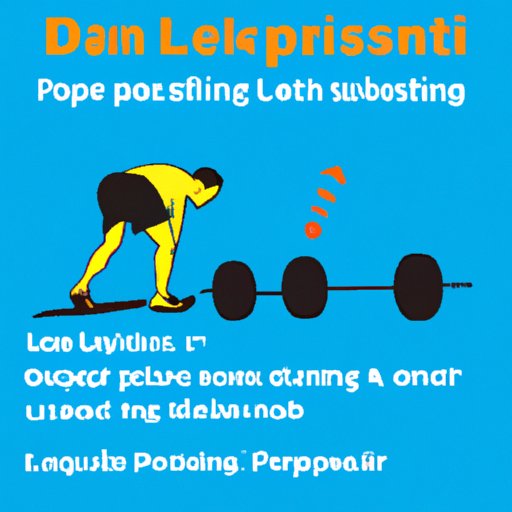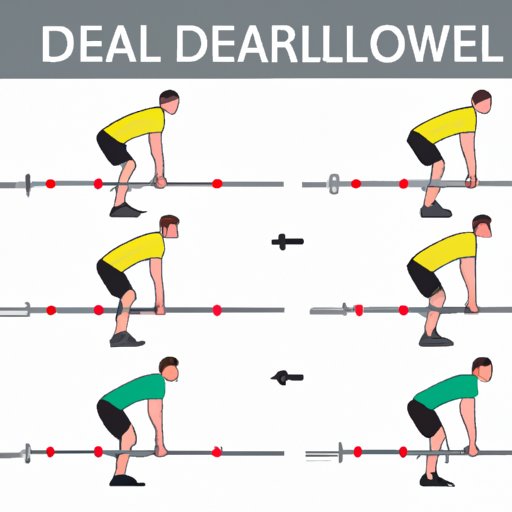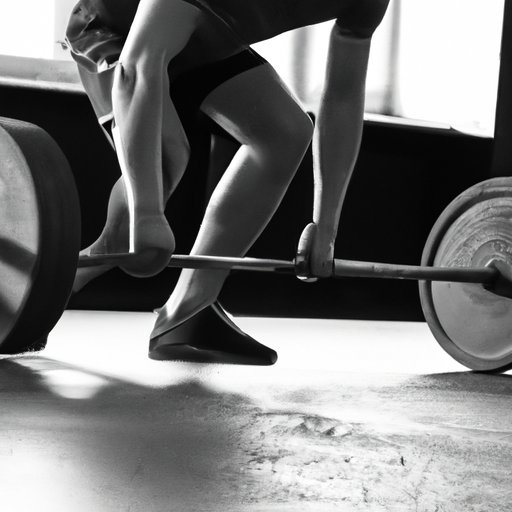Introduction
Deadlift is an exercise that involves lifting weights off the ground, usually barbells. It is a compound exercise that works multiple muscle groups in the body, including the glutes, hamstrings, lats, traps, and lower back. The deadlift is one of the most effective exercises for developing strength and power, and it can be used to improve overall physical fitness.

Benefits of Deadlifting for Strength and Fitness
The deadlift is one of the best exercises for building strength and muscle, as well as improving overall physical fitness. Here are some of the benefits of deadlifting:
Improved Core Strength
The deadlift is an excellent exercise for strengthening the core muscles, including the abdominal muscles, obliques, and lower back. By engaging these muscles during the exercise, you can improve your posture, balance, and stability. This can help reduce the risk of injury and improve your performance in other sports and activities.
Increased Muscular Endurance
When done correctly, the deadlift can help build muscular endurance. By engaging multiple muscle groups in the body, the deadlift can help improve your ability to perform multiple repetitions or extended periods of activity. This can help improve your overall muscular endurance and performance.
Enhanced Overall Physical Fitness
The deadlift is an effective exercise for improving overall physical fitness. By working multiple muscle groups, the deadlift can help improve your cardiovascular health, flexibility, and coordination. Additionally, the deadlift can help burn calories and fat, making it an effective exercise for weight loss.
How to Perform the Deadlift Exercise Properly
Performing the deadlift exercise properly is essential for avoiding injury and getting the most out of the exercise. Here are some tips for performing the deadlift exercise correctly:
Stance
To start the deadlift, stand with your feet slightly wider than hip width apart and your toes pointed slightly outward. Your shins should be close to the bar but not touching it. Keep your chest up and maintain a neutral spine throughout the exercise.
Grip
The grip you use will depend on your preference, but the most common grip is the double overhand grip. To do this, place your hands just outside your legs, with your palms facing down. Make sure your arms are straight and your wrists are in line with your forearms.
Step-by-Step Instructions
Once you have set up your stance and grip, you are ready to begin the deadlift. Follow these steps to perform the exercise correctly:
- Take a deep breath and brace your core.
- Push your hips back and engage your glutes.
- Keeping your chest up and shoulders back, drive through your heels and lift the bar off the ground.
- Continue to push your hips forward as you stand up straight with the bar.
- Slowly lower the bar back to the ground and repeat.

Common Deadlifting Mistakes and How to Avoid Them
There are several common mistakes people make when performing the deadlift exercise. Here are some of the most common mistakes and how to avoid them:
Rounding Back
One of the most common mistakes people make when deadlifting is rounding their back. This can put excessive strain on the lower back and lead to injury. To avoid this, focus on keeping your chest up and maintaining a neutral spine throughout the exercise.
Dropping the Bar Too Soon
Another common mistake is dropping the bar too soon. This can cause the bar to bounce off the floor and increase the risk of injury. To avoid this, control the bar as you lower it back to the ground and keep your arms straight.
Not Keeping Shoulders Back
Many people forget to keep their shoulders back when deadlifting. This can cause the bar to drift away from your body and increase the risk of injury. To avoid this, focus on keeping your chest up and your shoulders pulled back throughout the exercise.

Different Variations of the Deadlift Exercise
While the traditional deadlift is an effective exercise, there are several variations that can help target different muscles and increase the difficulty of the exercise. Here are some of the most popular variations of the deadlift exercise:
Sumo Deadlift
The sumo deadlift is a variation of the traditional deadlift that targets the inner thighs and glutes. To perform the sumo deadlift, stand with your feet wider than shoulder width apart and your toes pointed outward. Grip the bar with a wide grip and keep your chest up as you lift the bar off the ground.
Trap Bar Deadlift
The trap bar deadlift is another variation of the traditional deadlift. It is performed using a trap bar, which is a hexagonal shaped bar with handles on either side. This variation puts less strain on the lower back and allows you to lift heavier weights. To perform the trap bar deadlift, stand in the middle of the bar with your feet hip width apart and grip the handles. Push your hips back and drive through your heels to lift the bar off the ground.
Single-Leg Deadlift
The single-leg deadlift is a variation of the traditional deadlift that targets the glutes and hamstrings. To perform the single-leg deadlift, stand with your feet hip width apart and hold the bar with one hand. Lift one leg off the ground and hinge at the hips, pushing your hips back and lowering the bar towards the ground. Return to the starting position and repeat on the other side.
Deadlifting Tips for Beginners
If you are new to deadlifting, here are some tips to help you get started:
Start Light
It is important to start light and focus on proper form before increasing the weight. Start with a weight that is comfortable for you and gradually increase the weight as you become more comfortable with the exercise.
Use a Mirror
Using a mirror can help you monitor your form and ensure you are performing the exercise correctly. Stand in front of a mirror while performing the deadlift and check your form to make sure you are not making any mistakes.
Hire a Trainer
If you are new to deadlifting, it may be beneficial to hire a trainer to help you learn proper form. A trainer can help you identify any mistakes you may be making and correct them before they become habits.
The Science Behind the Deadlift Exercise
The deadlift is a compound exercise that engages multiple muscle groups in the body. Here is a closer look at the science behind the deadlift exercise:
Muscles Used During the Deadlift
The deadlift is a compound exercise that works multiple muscle groups in the body, including the glutes, hamstrings, lats, traps, and lower back. Additionally, the core muscles are engaged during the exercise to stabilize the body and maintain proper form.
Benefits of Deadlifting on Performance
The deadlift is an effective exercise for improving strength, power, and overall physical fitness. Studies have shown that deadlifting can improve muscular strength, power, and endurance, as well as running speed, jumping ability, and agility. Additionally, deadlifting can help build lean muscle mass and burn calories, making it an effective exercise for weight loss.
Safety Considerations when Deadlifting
It is important to keep safety in mind when performing the deadlift exercise. To avoid injury, make sure to use proper form and lift within your capability. Additionally, if you are new to deadlifting, it is recommended to start light and work with a trainer to learn proper form.
Conclusion
The deadlift is an effective exercise for building strength, power, and overall physical fitness. It is important to learn proper form and technique in order to maximize the benefits of the exercise and minimize the risk of injury. With practice, the deadlift can be an effective exercise for improving overall health and performance.
(Note: Is this article not meeting your expectations? Do you have knowledge or insights to share? Unlock new opportunities and expand your reach by joining our authors team. Click Registration to join us and share your expertise with our readers.)
